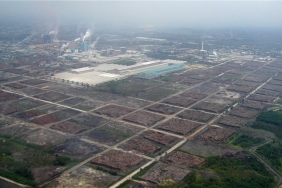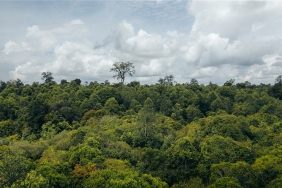PIG-SNOUTED TURTLES SHOULD REMAIN 'PROTECTED' STATUS
Jayapura - Regarding the Ministry of Environment and Forestry's plan to downgrade the status of the Pig-snouted Tortoise (Carettochelys insclupta) from 'protected species' to 'hunting species', WWF-Indonesia has sent a letter to the Ministry of Forestry dated September 16, 2014, requesting that the change in the status of this animal not be made. Considerations include the unavailability of adequate information on population and distribution, as well as the rampant smuggling of this animal. In addition, downgrading the status of this animal must also be preceded by a study of the possible economic, social and ecological impacts.
Rejection of the change in the status of the Pig-snouted Turtle was also submitted to the Ministry of Forestry by the Asmat Regency Government through Regent Letter Number 0331708/BUP/Asmat/X/2014, October 16, 2014; and the Mimika Regency Government through the Mimika Regency DPRD Letter Number 523/ 34/ DPRD, April 3, 2014.
The population of Pig-snouted Turtles in the wild continues to decline due to poaching and illegal trade. Based on the International Convention on Trade in Endangered Species of Wild Fauna and Flora (CITES), the Pig-snouted Tortoise is included in Appendix II, which is a threatened species, but can still be utilized. However, its utilization must go through quota determination. The quota is based on adequate information about the population and distribution of the animal and an assessment that its utilization will not threaten its population in nature. The World Conservation Organization (IUCN) lists the Pig-snouted Tortoise as IUCN Vulnerable Red List.
Benja V. Mambai, WWF-Indonesia's Papua Program Director stated, "WWF hopes that the provincial government can provide support to the regency government and make wiser efforts such as conducting in-depth research and monitoring of the habitat and population numbers of the Pig-snouted Turtle. It is also necessary to take firm action against cases of poaching and illegal trade related to the Pig-snouted Turtle." Benja continued, "WWF hopes that the Ministry of Forestry will reconsider the plan to change the status of the Pig-snouted Turtle from 'protected animal' to 'hunting animal', because this change is feared to threaten the sustainability of the protected animal."
The protection status of the Pig-snouted Tortoise, which is endemic to South Papua, dates back to 1931, through the Ordinance for the Protection of Wild Animals. Its status as a protected animal was then strengthened in 1978, through Decree of the Minister of Agriculture No. 327/Kpts/Um/51978 and through PP No.7 of 1999 concerning the Preservation of Plants and Wildlife. The population and habitat of the Pig-snouted Turtle must be protected in order to provide sustainable benefits to society.
"The Pig-snouted Turtle has great potential to be a source of economic income for the community, but it must be based on adequate information, both population size and distribution," continued Benja. The government is expected to develop a mechanism for sustainable utilization of the Pig-snouted Turtle by the community while still considering the preservation of its habitat and population, for example through the development of ecological tourism.
For further information please contact:
- Benja V. Mambai, Director of Papua Program, WWF-Indonesia
E-mail: Bmambai@wwf.or.id, Hp: +628124809407
- Chairul Saleh - Species Coordinator, WWF Indonesia
E-mail: Csaleh@wwf.or.id, Hp: +62811102902
- Andhiani M. Kumalasari , Communication, Campaign, and Outreach Coordinator, WWF- Indonesia - Papua Program
E-mail: akumalasari@wwf.or.id, Hp: +6282133183738
Notes:
- The Pig-snouted Tortoise is a slow-growing animal that takes about 10 years to become an adult turtle ready to breed.
- Ecologically, the Pig-snouted Turtle plays an important role in the sustainability of the ecosystem, namely as a water pollinator through its feces. This animal also plays a role in spreading the seeds of various types of plants in coastal areas and wetlands which indirectly helps preserve these plants which also provide benefits as a green belt against abrasion and flooding.




